- Quick Read
- Deep Read ( 5 Min. )
Monitor Daily Podcast
- Follow us:
- Apple Podcasts
- Spotify
- RSS Feed
- Download
TODAY’S INTRO
Reporting on hope, compassion, and progress in the Middle East
Recently, when the Monitor invited readers to a webinar with our Middle East correspondent, Taylor Luck, we noted one of the key challenges for reporters in the region: News outlets tend to focus on stories of religious, political, or social conflict, but the appetite for stories that help us better understand the people who live there – who get up each day and go to work, raise families, worry about bills, start new ventures, finds paths to progress – is often weaker. So how do you correct that imbalance?
Watch the video, and you’ll hear some answers. Taylor talks about the big issues – from Iran-U.S. relations to the Arab Spring and “winter.” But he also shares thoughts about what makes Monitor journalism different, including the wide range of places from which he reports. Taylor says his interviewees are often almost shocked that a U.S.-based news outlet wants to hear what they have to say – be it about Black Tunisians confronting racism or Bedouin concepts of conflict resolution.
“I explain we are exploring shared experiences of shared humanity,” he says. “We express it in different tones, but it’s still the same common challenges and triumphs, and we enrich ourselves by learning more about others. And they latch onto that. So we’re not just challenging our readers’ views of the Middle East, we’re challenging views of people in the region in terms of what our values and journalism represent. We are having an equal relationship between interviewee, reporter, and readers. And you can’t explore progress till you first put everyone on a level playing field.”
Share this article
Link copied.

Help fund Monitor journalism for $11/ month
Already a subscriber? Login

Monitor journalism changes lives because we open that too-small box that most people think they live in. We believe news can and should expand a sense of identity and possibility beyond narrow conventional expectations.
Our work isn't possible without your support.
As recovery falters, can Washington reach a deal?
Political continuity is a key way to battle economic uncertainty. But as the U.S. economy’s recovery shows signs of faltering, brinkmanship is taking center stage – and a sharp toll on confidence.
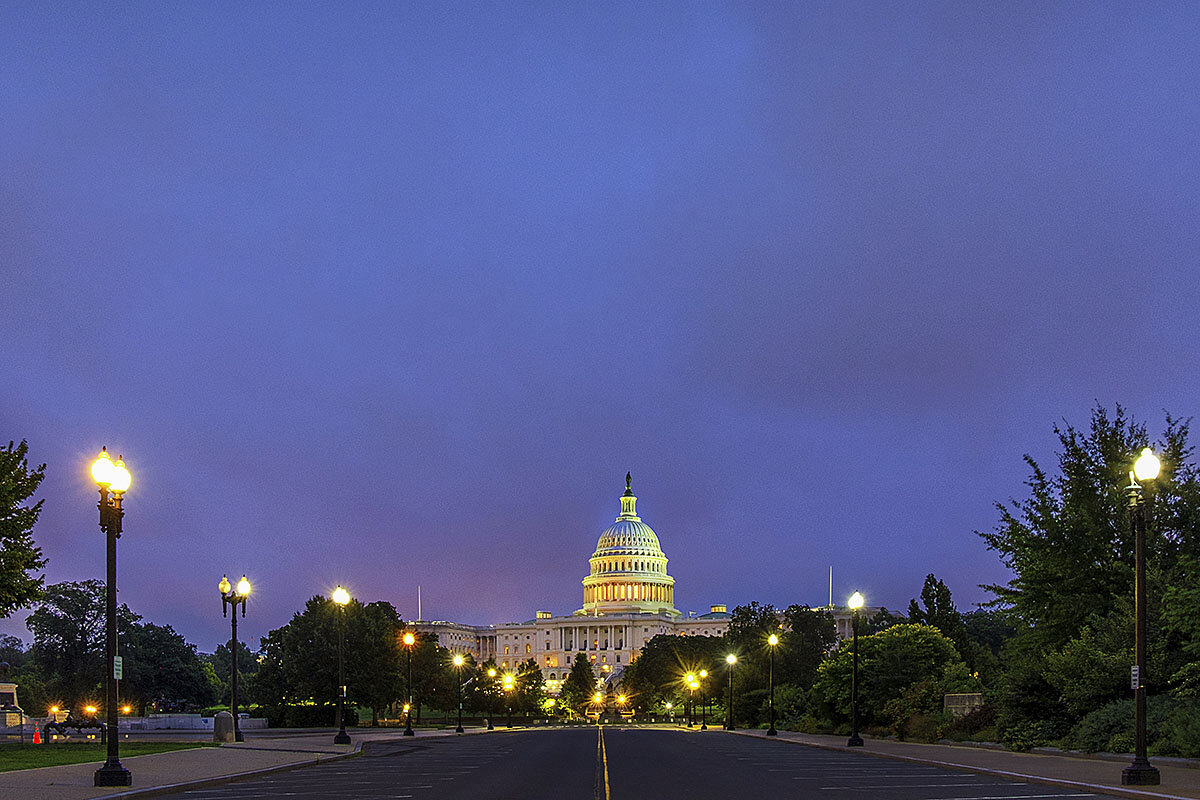
The federal relief money has helped millions of Americans, from an unemployed line cook in Boston to the owner of a dance school in greater Houston. But now Congress and the White House have thrown a monkey wrench into the machinery. They have let expire two programs that have kept the jobless and small businesses afloat during the economy’s pandemic-induced plunge. Talks between House Democrats and the Trump administration collapsed Friday. So far no new negotiations are scheduled.
The president on Saturday issued several executive orders to try to keep some of the unemployment benefits flowing and avoid some evictions. But the orders will be challenging, perhaps impossible, for states to implement and are constitutionally questionable, since Congress, not the president, controls the government’s purse strings.
Evidence is piling up that the additional unemployment benefits and loans to small businesses have proved useful in alleviating the downturn. But now that recovery appears to be stalling and the longer the impasse between the political parties goes on, economists say, the greater the damage to workers and businesses alike.
“This is a war against a virus,” says Rafael Abarca, the cook in Boston. “They turn it into a civil war.”
As recovery falters, can Washington reach a deal?
Rafael Abarca is a patient man.
Ever since he lost his job as a line cook in a high-end Boston steakhouse in March, he’s been unemployed and hasn’t succeeded in collecting benefits from the state of Massachusetts. Except for the odd job he can pick up from friends and the hours of weekly temp work his longtime partner can get, he’s had no income to stash away. His relief check went to pay back rent.
Despite all this, he remains upbeat, except when it comes to Congress. “This division they have between [the House] and Senate is just ridiculous,” he says. “This is a war against a virus. ... They turn it into a civil war.”
By failing to pass a relief bill so far and letting programs lapse that have kept the unemployed and small businesses afloat during an unprecedented downturn, Congress is risking raising the ire of voters less than three months before the election. It is also taking a huge economic risk at a time when the nation’s recovery is showing signs of stalling. Rather than reducing uncertainty, the nation’s politicians are raising it. By allowing key relief programs to expire this past week, some economists argue that Congress is making recovery even more difficult as consumers and businesses lose confidence in the economy and reduce their spending.
The irony is that the political disagreement is not over whether to keep up Washington’s relief efforts. However imperfect, the federal relief programs have helped power a recovery from an economic plunge this spring that was faster and sharper than any recession in modern times. Instead, Congress is haggling over the size of a new relief package.
What’s needed to keep the recovery going, economists say, is continuity.
The political brinkmanship “introduces a big increase in uncertainty,” says Nicholas Bloom, an economist at Stanford University’s graduate business school. “The worst thing is that they wait until Labor Day [to reach a deal] and then backdate the checks,” he adds. The longer the impasse continues, the greater the economic damage. And there’s less relief bang for the buck, he adds, a little like advertising Christmas toys in January.
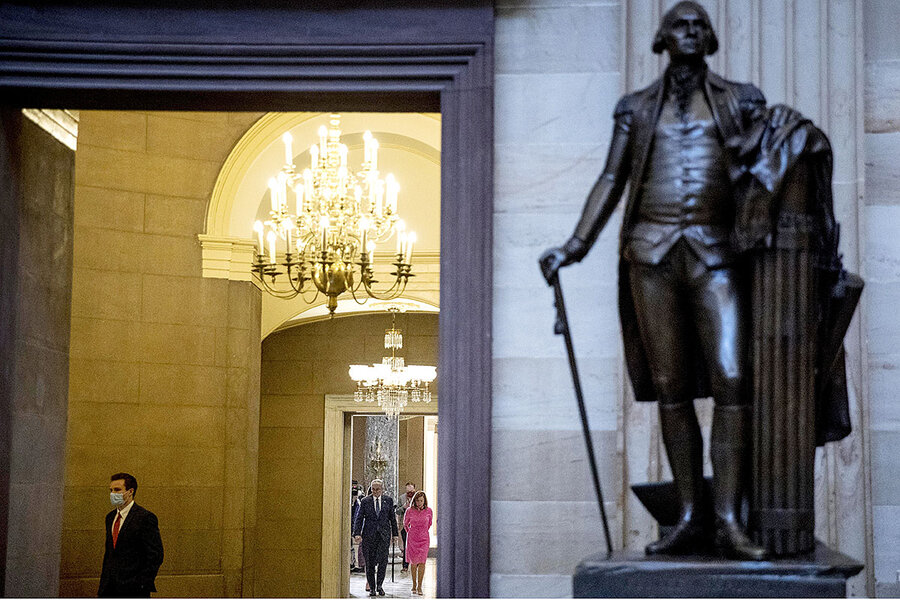
Politicians on both sides of the aisle acknowledge the need for more relief. In May, the Democratic-controlled House passed a $3 trillion-plus relief bill. Late last month, Senate Republicans unveiled a $1 trillion plan. After talks between House Democrats and the Trump administration collapsed this past Friday, President Donald Trump on Saturday signed a set of executive orders intended to keep some aid flowing to the unemployed.
While challenging to implement and constitutionally questionable – Congress, not the president, holds the power of the purse – the executive orders illustrate the White House’s sense of urgency. On Sunday, both Treasury Secretary Steven Mnuchin and House Speaker Nancy Pelosi signaled they could restart negotiations sooner rather than later. “Right now, we need to come to agreement,” Ms. Pelosi told Fox News.
The urgency stems from mounting evidence that the recovery is faltering. Last month, the U.S. created only a little over a third of the new jobs that it did in June. Unemployment remains above the worst levels of the Great Recession. Consumer spending, according to various measures, appears to have flatlined since mid-June.
Policy continuity is one important way to battle such uncertainty. “No matter what policymakers decide to do, it’s always good to know what’s going to happen in advance,” says Rachel Greszler, an economist with the Heritage Foundation in Washington.
One key area of contention between Democrats and Republicans is over special unemployment benefits. In March, Congress passed a huge relief package that included $600 a week in additional benefits to the unemployed who were already receiving state aid. Studies suggest this had a huge positive effect on the economy, allowing spending by low-income households to rebound smartly despite the loss of jobs. But it also created a controversy.
Thanks to the extra money, some two-thirds of recipients were getting more money from unemployment than they were when they were working, according to one study. Republicans charged the benefits were discouraging the unemployed from going back to work. Their $1 trillion or so relief package cut those benefits to $200 a week. Democratic leaders want to keep the level at $600, contending there were not enough jobs in hard-hit sectors like hospitality for everyone to go back to work.
The continued flow of federal money would help unemployed low-income workers who are dealing with a future clouded by everything from job prospects to school reopenings to evictions, says Mike Leyba, director of development for City Life/Vida Urbana, a tenant advocacy group in Boston. “People are overwhelmed right now with a sense of uncertainty. And this uncertainty, it permeates every part of their life.”
Economists across the ideological spectrum are suggesting compromise measures that would target the money more precisely. Ms. Greszler, of the conservative Heritage Foundation, has proposed a 40% federal match to state unemployment aid, with the idea of getting total benefits to around 70% of what the jobless previously earned – a level that would be gradually reduced over time. Former Obama administration officials Jason Furman and Timothy Geithner have suggested a $400 per week payment, which would fall as the state’s unemployment rate drops.
Another key program – forgivable loans to small businesses – garners more bipartisan support. Despite criticism that the Paycheck Protection Program (PPP) is overly complicated and sometimes aided foreign businesses, the $660 billion relief nevertheless helped boost the expected survival rate of a business by a huge 14 to 30 percentage points, according to a recent study.
The aid tended not to flow to the neediest businesses, according to the same study. It’s not clear whether that’s a bad thing, says Christopher Stanton, an economist at Harvard Business School and coauthor of the study. The neediest firms are the most likely to fail during a downturn and firms that looked stronger in the spring may have been weakened as the recession rolled into summer.
Despite constantly changing rules, a PPP loan helped Kim Davis when her Cypress Elite Dance Studio in Tomball, Texas, had to close in mid-March because of a statewide lockdown. She was able to keep all of her employees and pay them through the spring. Having reopened May 18 and relying on a combination of video instruction and live, socially distanced classes, she says she’d definitely consider another PPP loan if a new round of funding is approved by Congress. Receipts are down. Fall registration is so far only a little over half of last year’s level. Her level of optimism or panic varies by day.
But the biggest cloud on her horizon is not policy related. It’s the possibility of another lockdown in the face of a surge of coronavirus cases in Texas, she says. “My big fear is going to be that they shut us down.”
Editor’s note: As a public service, we have removed our paywall for all pandemic-related stories.

Parents to educators: Work with us to help special education students at home
Pandemic-related lockdowns pushed many people apart. But they also spurred new ideas about how to better support each other – as you'll see in this story about teachers and parents of special ed students.
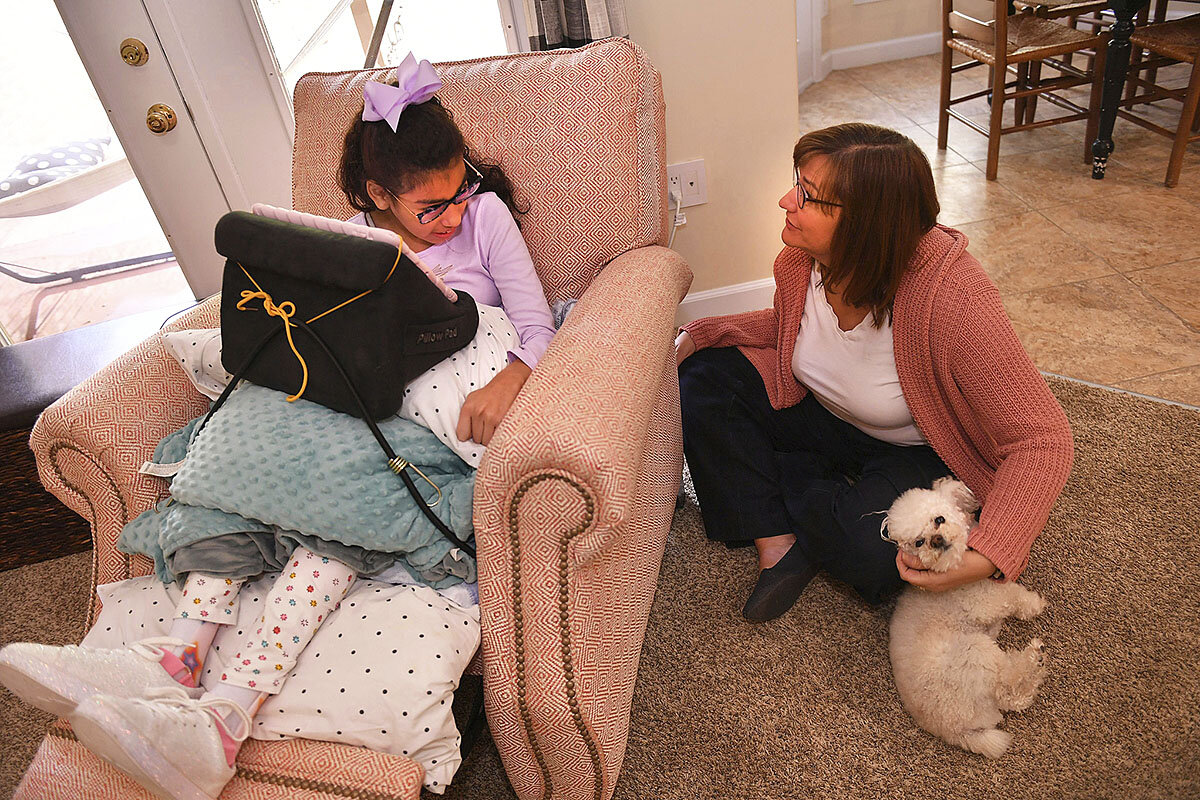
- Quick Read
- Deep Read ( 6 Min. )
-
By Hallie Golden Correspondent
Families and educators of the estimated 7 million special education students in the U.S. faced a myriad of challenges in the spring, as well as some out-of-the-box successes, after the coronavirus forced many to suddenly navigate remote learning.
Heading into the fall with a majority of the nation’s largest school districts planning to start the year online-only, parents and teachers again face the task of managing learning. This time around, though, adults won’t be starting from scratch, but building off the lessons learned in the spring. Among them: Collaboration is key.
Some parents found success when teachers offered specific directions about how to teach lessons and exact language to use. Even so, working together will likely mean frequent reevaluation, as many families encountered daunting challenges in the spring. The lessons learned are allowing some to see possibilities for how to make it through the fall.
“[I’m hopeful] that we all can take what we’ve learned from this process into the new school year,” says Denise Stile Marshall, CEO of the Council of Parent Attorneys and Advocates, a national organization that helps to protect the rights of students with disabilities. “But we also are concerned because of the unknowns.”
Parents to educators: Work with us to help special education students at home
For one week in March, Patty Leitz watched her 7-year-old son, Michael, who has been diagnosed with severe autism and is nonverbal, not follow her directions or even respond when she’d try to teach him at home.
Then everything changed. Michael’s special education teacher started sending her not only a video greeting for Michael and lesson plans and timing for everything every day, but also a five- to six-minute video for Ms. Leitz. In it, the teacher walked her through exactly how to teach her son.
“As soon as I came along and imitated the teacher and used the exact words that the teacher uses, all of a sudden he’s complying and doing everything immediately,” says the Columbus, Ohio, mother.
The daily lessons for both student and parent meant that Michael was keeping up with his skills. But they also empowered his mother, helping her realize that she can be an effective part of his education.
“To be able to sit there and watch my kid count money, knew a quarter is 25 cents, that he knew how to tell time, it was amazing,” she says.
Families and educators of the estimated 7 million special education students in the United States faced a myriad of challenges in the spring, as well as some out-of-the-box successes, after the coronavirus forced many to suddenly navigate remote learning. Heading into the fall with a majority of the nation’s largest school districts planning to start the year online-only, parents and teachers again face the task of managing learning. This time around, though, adults won’t be starting from scratch, but building off of the long list of lessons learned in the spring. Among them: Collaboration is key.
“This is where the parent is critical,” says Sean Smith, special education professor at the University of Kansas, who says the crucial role of guardians, particularly at the elementary level, was a surprise for some in the spring. “Part of the job of the teacher is to actually empower and interact and facilitate with the parent or the adult.”
Already districts, often asked about how they are planning to help their special education population, are prioritizing solutions and training. Some schools have explored offering evening or weekend support, in order to better accommodate families where parents work full time, says Professor Smith. The idea of having special education students start in person has also been suggested, with some parents petitioning for it, and some districts planning to give students priority access to buses to get them to on-site instruction. Some students already have been attending summer school.
Special education in the U.S. is based on the Individuals with Disabilities Education Act, or IDEA, which requires that districts provide individualized, appropriate, and free education for children with disabilities. It includes specifications about creating each student’s individualized education program, or IEP, which details annual goals and service needs.
In addition to academic instruction, some students require physical and occupational therapy, all of which has often been difficult to provide during the pandemic and has resulted in lawsuits by parents. The Department of Education, while encouraging flexibility, has generally not allowed waivers for IEP rules and has been firm in its message to schools: Find a way.
Lisa Thomas, associate director at the American Federation of Teachers, a union, says after the switch to remote learning in the spring, she noticed teachers and specialists, including occupational and physical therapists, working more collaboratively with each other and parents in order to adapt to the new reality.
“This pandemic forced a level of collaboration that they typically just didn’t have the opportunity to do in a regular school day,” she says.
In her own family, says Ms. Thomas, she saw a Maryland district develop a remote learning service plan as a supplement to her daughter’s IEP. With the teacher, physical therapist, occupational therapist, and other specialists all working together, they conducted an audit of her daughter’s services and figured out how all but seven hours of her 32-hour IEP could be done remotely.
Even so, working together will likely mean frequent reevaluation of what’s working and what isn’t. In March, when Chris and Jill Reffett helped their 9-year-old daughter, who has been diagnosed with Down syndrome and attention deficit hyperactivity disorder, participate in a Zoom social hour set up by her teacher, it was clear almost immediately it wasn’t going to work for her. The sessions were meant to give the students in the second grade classroom in Lawrence, Kansas, a chance to be around each other as they did an art project or some other type of activity together.
“She couldn’t get that they could actually see her on the other side. And to her it was noisy, it was uncontrolled,” says Ms. Reffett. “It made me a little bonkers. So for her, with ADHD, it was too much.”
Mr. Reffett says they ended up only having their daughter take part a few times, before skipping the social sessions altogether.
Julie Shepard and her husband in Spokane, Washington, had a similar experience with their 7-year-old son, Demetri, who has been diagnosed with autism and is legally blind.
For two months in the spring, Ms. Shepard managed to carve out time for his general education and special education lessons, as well as his more specialized services, including vision therapies. But the tablet he was using was too small for him to see clearly, and Demetri, who typically loves school, was becoming increasingly frustrated and angry trying to learn remotely. In May, she realized that this wasn’t working for her or her son: “It’s full time, and I can’t do my job and do his teaching full time,” she says.
They temporarily switched to just focusing on general education lessons and attending only one digital therapy appointment a week. The change improved his mood and allowed Ms. Shepard to keep up with everything, but his instructors told her he is falling behind.
This fall, overcoming situations like those will occupy special education teachers, who are already gleaning insights from the spring. Kareem Neal teaches 15 high school students in a self-contained special education classroom in Phoenix. In the spring, he started holding virtual class meetings every Monday with students and their families, and once a day one-on-one virtual lessons with each of his pupils. The result, he says, was a lot more communication and a stronger relationship with each family. He also says he has a better understanding of his students from observing them at home, pointing to one in particular as an example.
“I think it was really a telling thing to me to say, ‘Wow, he is in my classroom getting all the attention he can because he may go home and not get much,’” says Mr. Neal.
For some students, though, being at home may offer fewer distractions than a busy classroom, says Denise Stile Marshall, CEO of the Council of Parent Attorneys and Advocates, a national organization that helps to protect the rights of students with disabilities. A child may also thrive off of virtual sessions in which they are the central focus of their teacher’s attention, she adds.
For her own 7-year-old grandchild, who has been diagnosed with Down syndrome, she says simply being out of his special education classroom and among his typically developing siblings at home helped him: “He’s been saying a lot more words spontaneously because of that and really imitating what they’re doing all day long.”
Overall, she says she has mixed feelings about the fall. “[I'm hopeful] that we all can take what we’ve learned from this process into the new school year. But we also are concerned because of the unknowns. We don’t know how long this is all going to last. We don’t know what the continued effect is going to be for some students or whether they’ll receive the services that they need. And that’s worrisome.”

How two Nigerian women are breaking into comedy’s boys club
We all like a good joke. But what about comedy that comes at the expense of others? Check out how these two women’s ability to crack jokes without being dismissive or exploitative is winning them legions of fans.

- Quick Read
- Deep Read ( 4 Min. )
-
By Wilfred Okiche Correspondent
The world of professional comedy has long been a boys club, in Nigeria and elsewhere. But the internet is helping to democratize who gets to make Nigerians laugh.
Twenty-something comedians Maraji and Taaooma each have more than 1 million Instagram followers who enjoy their skits about Nigerian culture and family dynamics. While women are often the butt of male comedians’ jokes, these social media sensations say they are flipping the script and showing women can dish out humor too.
Both women would like to someday take their comedy to the silver screen in Nollywood – Nigeria’s booming film industry – which capitalizes on the country’s desire for locally told stories. In the meantime, they hope their rise can provide a template for others.
“It is amazing” to see women becoming popular comedians, says Maraji. “A lot of young women are on it right now. It’s their creativity and if I have been of help in any way, then I am honored.”
How two Nigerian women are breaking into comedy’s boys club
In a brightly colored sitting room somewhere in Nigeria, a couple and their teenage daughter are gathered comfortably in front of the television, watching a foreign film. Suddenly, the two characters on the screen kiss, and everyone freezes.
“Go inside!” shrieks the mother in panic, as her daughter scurries out of the room. For the next two minutes, the same scene plays out several more times, each with a different awkward parental reaction. In one iteration, the mother deflects the room’s attention by chattering away about grocery shopping. In another, the father flails frantically for the remote to change the channel.
Since it was first posted last year, this 2-minute skit by the rising Nigerian comedy star Gloria Oloruntobi (known as Maraji) – who plays mother, father, and daughter in the scene – has been watched more than 800,000 times on YouTube.
The video captures what has made the 20-something comedian such a viral sensation – her knack for using relatable social interactions to elicit laughs.
But her social media stardom also points to how the internet is helping democratize who gets to make Nigerians laugh. Like in many countries, the comedy scene here has historically been a boys club, where success meant making your way up through the male-dominated world of standup gigs, headline shows, and television appearances.
On the internet, there are no such gatekeepers. And for Nigerian women, that means they are finally beginning to see their own experiences reflected back on their smartphone screens. Instead of being the butt of male comedians’ jokes, female comedians like Maraji say they are flipping the script, showing that women can dish out humor too.
“I don’t know how it would have been possible for me to reach the audience that I have, both within and outside Nigeria, without the internet,” says Maryam Apaokagi (known as Taaooma), another young female comic, who has endeared herself to her 1.3 million Instagram followers with her skits lampooning traditional family dynamics.
Nigeria – home to the world’s second-largest film industry – has long been a country that put a premium on locally told stories. And just as a far-flung Nigerian diaspora and international streaming platforms like Netflix have helped give Nollywood a worldwide reach, the internet has given the country’s comedy a wider fan base.
Earlier this year, for instance, Nigerian comedian Josh Alfred (known as Josh2funny) touched off a global hashtag, #dontleaveme, with an Instagram video featuring a series of puns on the word leaf. By early August, the hashtag had close to 5 billion views on TikTok.
Like social media influencers the world over, Nigeria’s online comedians tend to be Generation Zers fluent in sharing their lives across a wide variety of digital platforms. But they’ve struck a particular chord here for their skill at poking fun at Nigerian culture from the inside.
And for Taaooma and Maraji in particular, their ability to crack jokes about Nigerian cultural sensitivities and domestic life without being dismissive or exploitative has won them legions of fans, says Fareeda Abdulkareem, a culture writer and development worker in Kaduna, who credits their high level of “imagination and empathy” for their success.

That distinguishes them, observers say, from a crop of comedians who have often leaned on sexism and homophobia for laughs. Taaooma’s skits, for instance, often explore family relationships, humorously probing the tensions between traditionally minded parents and their irreverent offspring.
The videos themselves are often clunky, with amateurish camerawork and editing. But that, their creators say, is part of the charm.
“The videos I create most times are not always set out to make people laugh but for people to relate to,” says Maraji, who has more than 1.2 million followers on Instagram. “I just live life and I don’t stress it really.”
But if the clips have an amateur’s charm, they are also the work of savvy businesswomen. Maraji and Taaooma live completely off the income they make from their comedy, often collaborating with local brands including banks and skin care lines – though both fell into comedy accidentally, pursuing their passion without an end goal in sight.
And both are clear that they would like to someday take their comedy to the silver screen as Nollywood actors and producers. In the meantime, they hope their rise can provide a template to other female comedians.
“It is amazing” to see other women becoming popular comedians on social media, says Maraji. “A lot of young women are on it right now. It’s their creativity and if I have been of help in any way, then I am honored.”

Points of Progress
Urban rooftop farm bears fruit, and more good news
We hear it from readers a lot: You really like Points of Progress. And we get that. It’s about more than feel-good news. It’s where the world is making concrete, credible progress. Here are six offerings for this week.
Urban rooftop farm bears fruit, and more good news
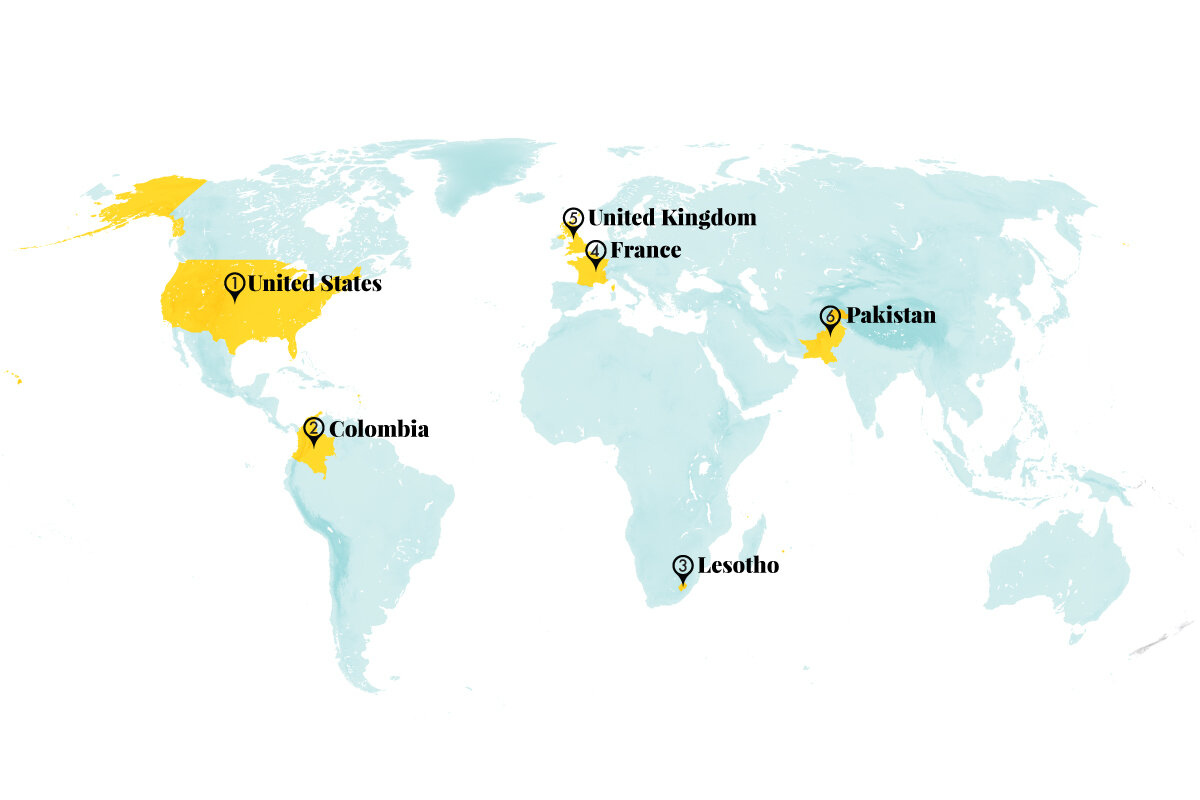
1. United States
The Navy welcomed its first Black female tactical jet pilot last month after Lt. j.g. Madeline Swegle completed her final undergraduate flight. In the 1980s, Brenda Robinson became the first African American woman to serve as a Navy flight instructor and VIP transport pilot, but she did not fly fighter jets.

In the years since, the Navy has often been criticized for its lack of diversity, especially among fighter units. A 2018 investigation found that of 1,404 Hornet pilots, only 26 were Black and 33 were female. The Navy’s Tactical Air (Strike) aviator program prepared Lieutenant Swegle to fly several tactical jets, including the F/A-18E/F Super Hornet. (CNN)
2. Colombia
Conservationists are training ex-combatants to help preserve Colombia’s biodiversity. Researching the country’s wildlife was a challenge during the decadeslong civil war, but since the 2016 peace agreement, expeditions in former conflict zones have discovered more than 150 new animal and plant species. Experts say ex-guerrilla fighters, who once occupied the most remote parts of Colombia’s jungles, forests, mountains, and savannas, are uniquely prepared to aid scientists with ongoing conservation efforts. Wildlife geneticist Jaime Góngora visits Colombia several times a year to conduct workshops training former members of the Revolutionary Armed Forces of Colombia (FARC) in various conservation skills, including taking biodiversity inventories. The project isn’t just helping scientists – a recent survey of 10,000 former FARC members found that 84% were interested in terrestrial and river environmental restoration work now that the war has ended. “This is a vital step to enable them to contribute to environmental projects, improve their livelihoods, and reincorporate into society,” says Mr. Góngora. (Science, The Conversation)
3. Lesotho
Kick4Life Football Club became the world’s first top-tier soccer club to fund men’s and women’s teams equally, a decision the club hopes will inspire other leagues to step up on behalf of women’s sports. Since Kick4Life’s women’s team was founded in 2010, it has rapidly grown into a competitive soccer team while challenging gender stereotypes in Lesotho and beyond. When coach Puky Ramokoatsi joined as a player a decade ago, Kick4Life helped her rethink her own biases and overcome violence from her past, she says. The decision to match funding for the men’s and women’s teams is especially poignant as the pandemic has put a financial strain on global sports. “These pressures are no reason to hold back,” says co-founder Steve Fleming. “Quite the opposite; the same crisis has given rise to an epidemic of gender-based violence here and elsewhere. The responsibility of football is to inspire positive change.” (The Guardian)
4. France
The world’s largest urban rooftop farm, called Nature Urbaine, has started bearing fruit. On one day recently, young farmers atop Paris Expo’s Pavilion 6 picked 3,000 lettuces and 150 pints of strawberries from aeroponic growing towers – plastic columns that are soil-free, use little water, and take up less space than traditional garden beds. The roof is the size of two soccer fields, but only a third has been planted. When it’s all in use, staff could harvest more than a ton of fruits and vegetables every day. Pascal Hardy, the engineer behind the garden, says his urban agriculture consultancy is fielding inquiries from around the world. “[This farming method] is a clean, productive, and sustainable model of agriculture that can in time make a real contribution to the resilience – social, economic, and also environmental – of the kind of big cities where most of humanity now lives,” said Mr. Hardy. “And look, it really works.” (The Guardian)
5. United Kingdom
Red kites are thriving in England after one of the world’s most successful reintroduction projects. The fork-tailed bird of prey was protected by royal decree throughout the Middle Ages, but became a target for taxidermists and egg collectors in the centuries that followed. “In the 1980s, anyone wanting to see a red kite had to make a special pilgrimage to a handful of sites,” said Jeff Knott, an operations director with the Royal Society for the Protection of Birds. “Today it is a daily sight for millions of people.”

In July 1990, 13 raptors flown in from Spain took their maiden flight across England. Thirty years later, there are an estimated 1,800 breeding pairs across England, and red kites are regularly seen flying through most counties. The United Kingdom is now home to almost 10% of the global red kite population. (The Guardian)
6. Pakistan
Pakistan has met United Nations Sustainable Development Goal 13 – to take urgent action to combat climate change – a decade before the deadline. The early achievement shows that progress is possible even for countries with limited resources. Pakistan met the target well before 2030 through a series of environmental programs launched over the last decade. These include the Billion Tree Tsunami project, a nationwide reforestation effort started by Prime Minister Imran Khan in 2014, and the Clean Green Pakistan Index, which ranks cities and townships based on residents’ access to clean water and green spaces. Pakistan has consistently ranked in the top 10 countries most vulnerable to extreme weather caused by climate change. (VOSA)
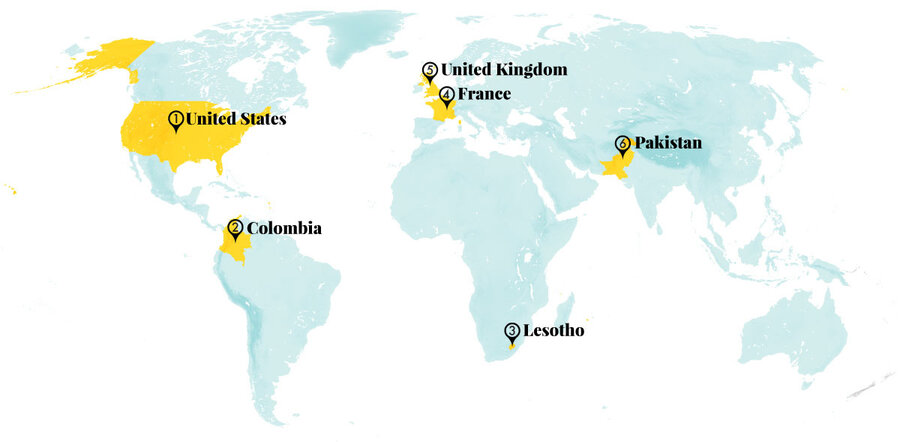
Other headline stories we’re watching
(Get live updates throughout the day.)The Monitor's View
Why nations rush to save Lebanon
- Quick Read
- Deep Read ( 2 Min. )
-
By the Monitor's Editorial Board
Leaders of nearly 30 countries met virtually on Sunday to fill a vacuum of governance in one of the world’s most fragile states. They agreed to provide aid to Lebanon, just days after a giant explosion rocked the capital. The speed of the humanitarian response was impressive. But what was rare was the decision to ensure the aid directly reaches the Lebanese people with “utmost efficiency and transparency.”
Such qualities of governance have been missing for a long time in Lebanon, triggering mass protests last October. Rather than allow the aid to flow through a disunited and corrupt bureaucracy, the donors plan to channel it through nongovernmental organizations.
The aid bypass reveals the latest chapter in the international community’s attempt to deal with a 21st-century challenge: weak states imploding from a lack of governance. To head off a potential rise in chaos, violence, famine, or exodus of refugees, the world came together quickly after the Aug. 4 explosion in Beirut in an attempt to fill a vacuum of governance. The aid itself is almost secondary to the signal sent about finding the common good that helps keep the world safe.
Why nations rush to save Lebanon

Leaders of nearly 30 countries met virtually on Sunday to fill a vacuum of governance in one of the world’s most fragile states. They agreed to provide aid to Lebanon, just days after a giant explosion rocked the capital. The speed of the humanitarian response was impressive. So was the amount of pledged donations – nearly $300 million. But what was rare was the decision to ensure the aid directly reaches the Lebanese people with “utmost efficiency and transparency.”
Such qualities of governance have been missing for a long time in Lebanon, triggering mass protests last October. Two prime ministers have fallen since then, the latest on Aug. 10. Rather than allow the aid to flow through a disunited and corrupt bureaucracy, the donors plan to channel it through nongovernmental organizations. Spain, for example, will deliver wheat to a nonprofit. Brazil will send rice. Egypt is providing field hospitals.
“In these horrendous times, Lebanon is not alone,” concluded the statement from the Aug. 9 video conference.
The aid bypass reveals the latest chapter in the international community’s attempt to deal with a 21st-century challenge: weak states imploding from a lack of governance. To head off a potential rise in chaos, violence, famine, or exodus of refugees, the world came together quickly after the Aug. 4 explosion in Beirut in an attempt to fill a vacuum of governance.
The coalition of political parties that holds power in Lebanon has been unable to pay the country’s huge debt, feed its people, provide electricity, or prevent the flow of arms to the terrorist group Hezbollah. With power divvied up between religious-based parties, Lebanon needs a touchstone for good governance. The foreign donors will be working with private groups that come with a record of legitimacy and competency.
The world order depends on preventing fragile states from becoming failed ones – places like Somalia, Syria, Yemen, and Zimbabwe. With so many Lebanese citizens clamoring for democracy based on transparency, accountability, and equality, it was easy for so many nations to respond to the crisis. The aid itself is almost secondary to the signal sent about finding the common good that helps keep the world safe.

A Christian Science Perspective
Each weekday, the Monitor includes one clearly labeled religious article offering spiritual insight on contemporary issues, including the news. The publication – in its various forms – is produced for anyone who cares about the progress of the human endeavor around the world and seeks news reported with compassion, intelligence, and an essentially constructive lens. For many, that caring has religious roots. For many, it does not. The Monitor has always embraced both audiences. The Monitor is owned by a church – The First Church of Christ, Scientist, in Boston – whose founder was concerned with both the state of the world and the quality of available news.
How to stop a war
- Quick Read
- Read or Listen ( 4 Min. )
-
By Emily Byquist
It may seem absurd to think that we, as individuals, can truly have an impact in resolving conflicts, whether large or small. But the realization that no problem is too big for God empowers us to serve as peacemakers wherever we may be.
How to stop a war
It was the 1960s, and the Vietnam War was raging. Like many members of my generation, I very much wanted to help bring it to an end. I felt impelled to pray about the conflict, but it was hard to believe that the prayers of one college student could have any real impact on such a formidable problem.
Then the subject came up in my Christian Science Sunday School class. The other students and I asked our teacher whether one person’s prayer could really have an effect on pressing global issues, particularly those, like war, that have plagued humanity throughout history. Our teacher assured us that it could, and she gave each of us an assignment: Go and stop a war.
I had never heard anything so outrageous. How could an inconsequential person like me – a college student – stop a war? While I was by no means a radical, I had been supporting the peace movement for some time, and my association with it had left me certain of one thing: Ending a war is a long and complicated process.
But I was inspired by a statement by Mary Baker Eddy, the discoverer of Christian Science: “You have simply to preserve a scientific, positive sense of unity with your divine source, and daily demonstrate this. Then you will find that one is as important a factor as duodecillions in being and doing right, and thus demonstrating deific Principle. ... Each of Christ’s little ones reflects the infinite One, and therefore is the seer’s declaration true, that ‘one on God’s side is a majority’ ” (“Pulpit and Press,” p. 4).
What did it mean, I wondered, to be “on God’s side”? Mrs. Eddy said that it is to understand our unity with God. To me this meant refusing to see God’s creation as fractured, split, or warring, and instead seeing all of His children as whole, complete, dwelling forever in unity. With God there are no sides, no divisions. There is only God, the infinite One.
As it happened, it wasn’t long before I had three opportunities to put these ideas into practice. The first came on Monday morning, when I climbed aboard the jammed city bus to go to school. The atmosphere was fractious.
I decided to stop a “war” right there. I saw that because God’s love for His creation is infinite, boundless, there was enough room and grace for everyone. And I actually experienced a heartfelt love for every individual on that bus.
Right away, the whole group calmed down, and the rest of the trip was perfectly harmonious.
That was a powerful taste of what it means to allow myself to be the expression of divine Love, God, whose presence was more than powerful enough to transform the mood on the bus.
My next opportunity to “stop a war” – to see and demonstrate man’s unity with God – came a short time later at a meeting to address issues between students and faculty at my college. The conversation devolved into a tense standoff.
Once again I prayed, acknowledging God as the one legitimate Mind. That meant we were united as the expression of divine Mind, as children of God, as brothers and sisters.
All of a sudden, an entirely new solution to one of the issues was proposed, and it was quickly determined to be acceptable to everyone. Then that happened with the next issue. And the next. Before long, every difference that had divided us was resolved.
It is within God’s power to resolve any conflict. To truly be on God’s side means to let go of any preconceived idea of how a conflict should be resolved, and to acknowledge the infinite power of Love, allow ourselves to be the expression of it, and let Love do its job.
Not long after this powerful experience, I participated in a large protest against the Vietnam War. It was troubling when we saw a phalanx of police officers approaching on horseback. This was an era when not all antiwar demonstrations ended peacefully.
I turned to God in prayer. This time it occurred to me that I needed to identify myself as more than a member of the “peace generation” – to acknowledge my true, spiritual identity as the individualized expression of the infinite One. That was really who I was. And that was who everyone else was as well.
That doesn’t mean that we can’t have our own points of view or expressions of individuality. But humbly acknowledging and striving to demonstrate man’s unbreakable unity with God brings unity to the human scene. And even one individual can help bring that about through prayer.
So how did the confrontation end? The police simply turned around and left. Then the protesters dispersed, too.
It’s not always easy, of course. But one on God’s side really is a majority. Each one of us can make a powerful contribution to stopping wars – and preventing them from starting – right where we are. We can all be peacemakers.
Adapted from an article published in the Feb. 23, 2015, issue of the Christian Science Sentinel.

A message of love
In the shadow of a volcano
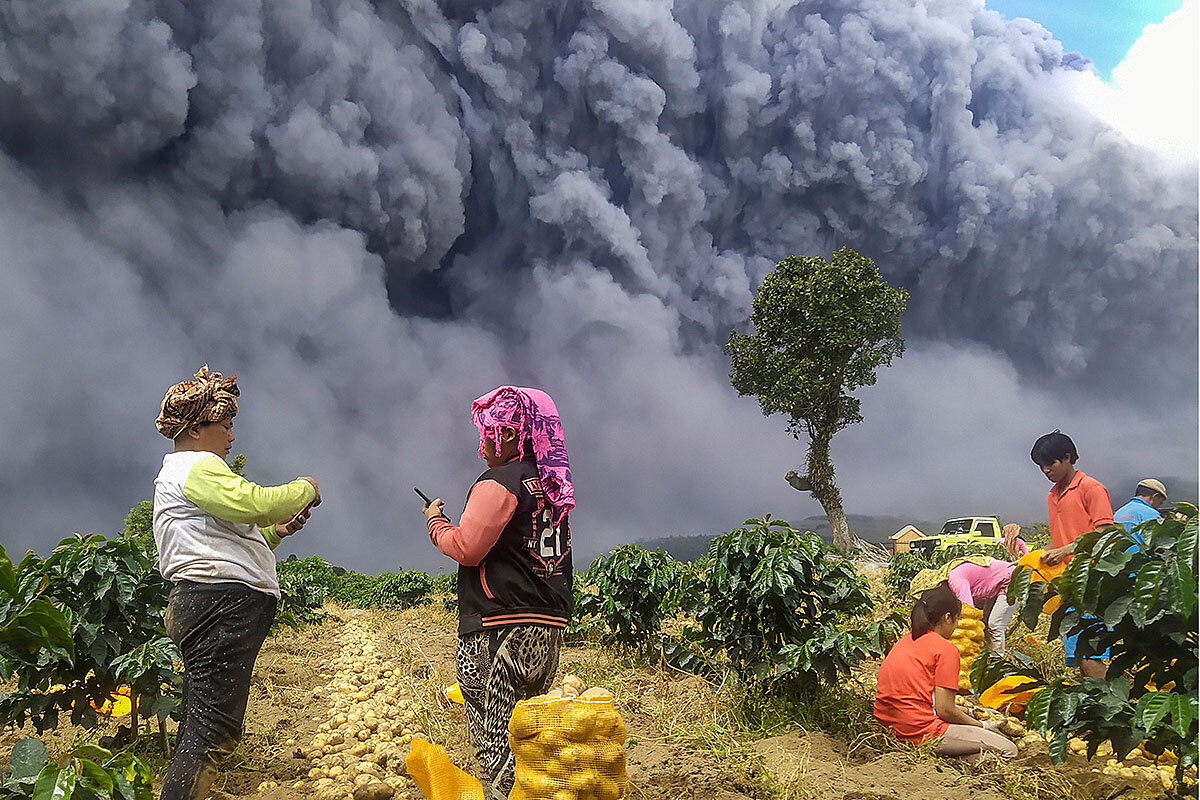
A look ahead
As always, thanks for starting your week with us! I hope you’ll tune in tomorrow for our podcast, “Perception Gaps.” In this second episode of Season 2, we hear about why white and Black Americans view the justice system differently.




